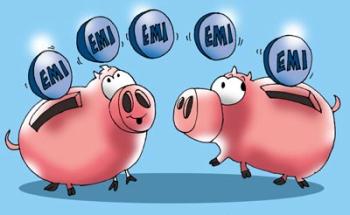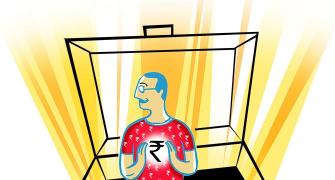
Over a five-year period, the benefit of a sharp drop in interest rates would mean saving Rs 76,880 -- a significant number.
But if the rate cuts are slimmer, say 25 bps or the number of years left is barely one or two years, shifting may not make too much sense.
Tinesh Bhasin reports.
Illustration: Uttam Ghosh/Rediff.com
With the State Bank of India (SBI) and other public and private sector banks cutting interest rates by 50 to 90 basis points (bps) sharply, it would be a good time for home loan borrowers who are still on the base rate, to shift to rates based on the Marginal Cost of fund-based Lending Rate (MCLR).
Reason: While the SBI has cut 50 bps (100 basis points = 1%) for customers who are on MCLR, customers on the base rate will get a benefit of only 5 bps.
In fact, customers who have borrowed recently (less than a year ago), will have to wait for a whole year to avail of the benefit of the rate cut.
"Under the MCLR regime, the interest rates for a borrower is reset only once a year -- on anniversary of the loan," says Ranjit Punja, CEO and co-founder, CreditMantri.
If your loan is benchmarked to the base rate, shifting to an MCLR regime would lower your interest rates and help you save money.
"A borrower can wait for another quarter or two and see if the rates would come down further before shifting," suggests Punja.
Most public sector banks are currently offering two options for existing borrowers to shift to MCLR: shift for free and rate will be reset after one year or pay 0.5% or a minimum of Rs 10,000 to get the benefit of shifting immediately.
"But, the relief if you choose the latter is that the customer doesn't need to pay this money upfront. It can be added to the equated monthly instalment (EMI)," explains Vaijinath M G, chief general manager (real estate and housing department), SBI.
But, does it make sense to shift always?
Not necessarily.
Say, you took a loan of Rs 50 lakh for 15 years under the base rate mechanism at 9.5%, your EMI would be Rs 52,211.
Considering the rate of interest rate stayed static in the past 10 years, your outstanding would be Rs 24.53 lakh.
Now, if the new rate is 9%, your EMI will fall by around Rs 1,280 to Rs 50,337. To get it converted to MCLR, you would have to pay around Rs 12,000.
Over a five-year period, the benefit of just a sharp drop in interest rates would mean saving Rs 76,880 -- a significant number.
But, if the rate cuts are slimmer, say 25 bps or the number of years left is barely one or two years, shifting may not make too much sense.
For customers who shift to MCLR, there are two options: Either reduce EMI or tenure.
The bank, usually, reduces the tenure and keeps the EMI same.
If you want to keep the tenure same, you have to approach the bank.
Another way a rate cut will benefit is by increasing the eligibility limit of new borrowers.
A borrower earning Rs 1 lakh a month is eligible for a home loan of Rs 55 lakh for 20 years if the lender caps EMI at 50% of the monthly income.
The same individual will can now get a Rs 58 lakh loan.
For a 25-year loan, the eligibility goes up to Rs 62 lakh from the earlier Rs 59 lakh.
Flush with funds after demonetisation, many public sector banks and a few private ones have started reducing their benchmark lending rates.
Punjab National Bank has cut MCLR by 70 basis points, Union Bank by 60 to 90 bps across tenors and SBI by 90 bps.
While banks have announced reduction in the benchmark rates, they are yet to announce the new interest rates on different loans.










